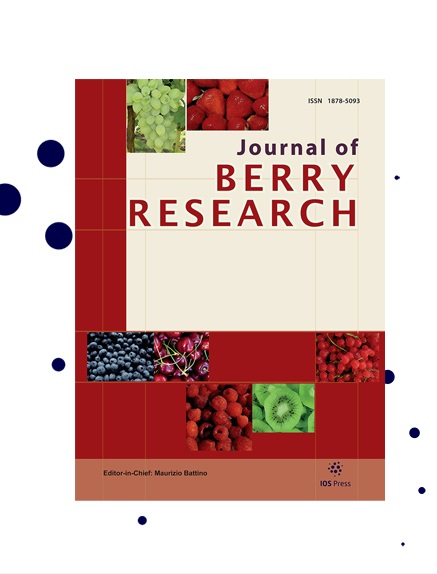Comparative variability of nutrients, minerals, phenolics and anthocyanins with antioxidant potentials during fruit development stages in five Mulberry ( Morus) cultivars
IF 1.4
4区 农林科学
Q3 PLANT SCIENCES
引用次数: 0
Abstract
BACKGROUND:Mulberry (Morus) from the Moraceae family is distributed widely in tropical to temperate regions of the world having economic and medicinal significance with exceptional nutritional characteristics. OBJECTIVES:Assessment of variations in sugars, acidity, minerals, total phenolics, anthocyanins and antioxidant potentials of three black mulberry (Morrus serrata, M. nigra and M. macroura black) and two white mulberry cultivars (M. alba and M. macroura white) during development stages. METHODS:Total sugars and acidity were evaluated with AOAC methods and total phenolic content was estimated with folin-ciocalteau method. Antioxidant activity was evaluated with DPPH assay, minerals were quantified with atomic absorption spectroscopy and anthocyanins were assessed and identified with high performance liquid chromatography and liquid chromatography-mass spectroscopy. RESULTS:Over all, M. alba (white cultivar) displayed maximum sugar (1.35%) at fruit development stage 3 (FDS-3) following M. serrata (black cultivar) at FDS-5 (1.1%) and M. macroura white (white cultivar) at FDS-4 (0.9%). Acidity decreased in M. alba (0.8–0.09%), M. nigra (0.8–0.03%) and M. macroura white (0.6–0.04%) during development. Total phenolic content was maximum (590 GAE/100 g) in M. nigra at FDS-6 and M. serrata (450 GAE/100 g) at FDS-7. Two black cultivars (M. serrata and M. nigra) showed significant increase in total anthocyanins (14.57–100.06 and 14.13–201.87 CGE/100 g FW) from FDS-1 to FDS-7 while decrease in M. macroura black and M. macroura white (17.07–11.79 and 9.03–2.68) from FDS-1 to FDS-7. The DPPH inhibition of black mulberries was pointedly greater with significant levels of iron, copper, zinc, calcium, magnesium, sodium, phosphorus and potassium than white cultivars during maturity. HPLC and LC-MS procedures identified various anthocyanins in all cultivars including cyanidin, malvidin, pelargonidin and delphinidin. CONCLUSIONS:Mulberries with improved nutrition, acceptable range of metals, bioactive compounds and higher antioxidant potentials could be significant against various diseases like cancer, cardiovascular problems, neurodegenerative disorders, obesity, diabetes and other metabolic syndromes.5个桑树品种果实发育阶段营养物质、矿物质、酚类物质和具有抗氧化潜能的花青素的比较变异
背景:桑科桑树(Morus)广泛分布于世界热带至温带地区,具有独特的营养价值和经济价值。目的:评估三种黑桑(Morrus serrata, M. nigra和M. macoura black)和两种白桑(M. alba和M. macoura white)在发育阶段的糖、酸度、矿物质、总酚类物质、花青素和抗氧化潜力的变化。方法:用AOAC法测定总糖和酸度,用folin-ciocalteau法测定总酚含量。采用DPPH法测定其抗氧化活性,原子吸收光谱法测定其矿物质含量,高效液相色谱法和液相色谱-质谱法测定其花色苷含量。结果:总体而言,白毛栎在果实发育第3阶段(FDS-3)糖分最高(1.35%),其次是黑毛栎(FDS-5)和白毛栎(FDS-4),分别为1.1%和0.9%。白僵菌(0.8 ~ 0.09%)、黑僵菌(0.8 ~ 0.03%)和巨白僵菌(0.6 ~ 0.04%)在发育过程中酸度下降。总酚含量在FDS-6和FDS-7处理下最高,分别为590 GAE/100 g和450 GAE/100 g。从FDS-1到FDS-7, 2个黑色品种(黑毛栎和黑毛栎)的总花青素含量(14.57 ~ 100.06 CGE/100 g FW)显著增加(14.13 ~ 201.87 CGE/100 g FW),而从FDS-1到FDS-7,黑毛栎和白毛栎的总花青素含量(17.07 ~ 11.79和9.03 ~ 2.68)显著降低。成熟时期,铁、铜、锌、钙、镁、钠、磷、钾对黑桑DPPH的抑制作用明显强于白桑。HPLC和LC-MS鉴定了不同品种花青素含量,包括花青素、锦葵苷、天竺葵苷和飞燕草苷。结论:桑葚具有更好的营养、可接受的金属含量、生物活性化合物和更高的抗氧化潜力,可以显著预防各种疾病,如癌症、心血管疾病、神经退行性疾病、肥胖、糖尿病和其他代谢综合征。
本文章由计算机程序翻译,如有差异,请以英文原文为准。
求助全文
约1分钟内获得全文
求助全文
来源期刊

Journal of Berry Research
Biochemistry, Genetics and Molecular Biology-Biochemistry
CiteScore
3.50
自引率
11.80%
发文量
21
期刊介绍:
The main objective of the Journal of Berry Research is to improve the knowledge about quality and production of berries to benefit health of the consumers and maintain profitable production using sustainable systems. The objective will be achieved by focusing on four main areas of research and development:
From genetics to variety evaluation
Nursery production systems and plant quality control
Plant physiology, biochemistry and molecular biology, as well as cultural management
Health for the consumer: components and factors affecting berries'' nutritional value
Specifically, the journal will cover berries (strawberry, raspberry, blackberry, blueberry, cranberry currants, etc.), as well as grapes and small soft fruit in general (e.g., kiwi fruit). It will publish research results covering all areas of plant breeding, including plant genetics, genomics, functional genomics, proteomics and metabolomics, plant physiology, plant pathology and plant development, as well as results dealing with the chemistry and biochemistry of bioactive compounds contained in such fruits and their possible role in human health. Contributions detailing possible pharmacological, medical or therapeutic use or dietary significance will be welcomed in addition to studies regarding biosafety issues of genetically modified plants.
 求助内容:
求助内容: 应助结果提醒方式:
应助结果提醒方式:


